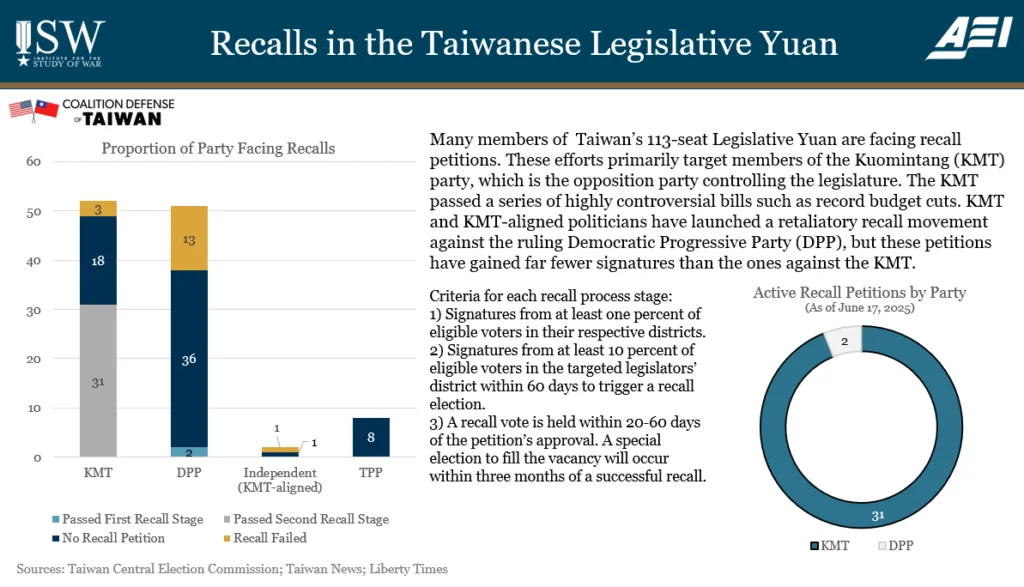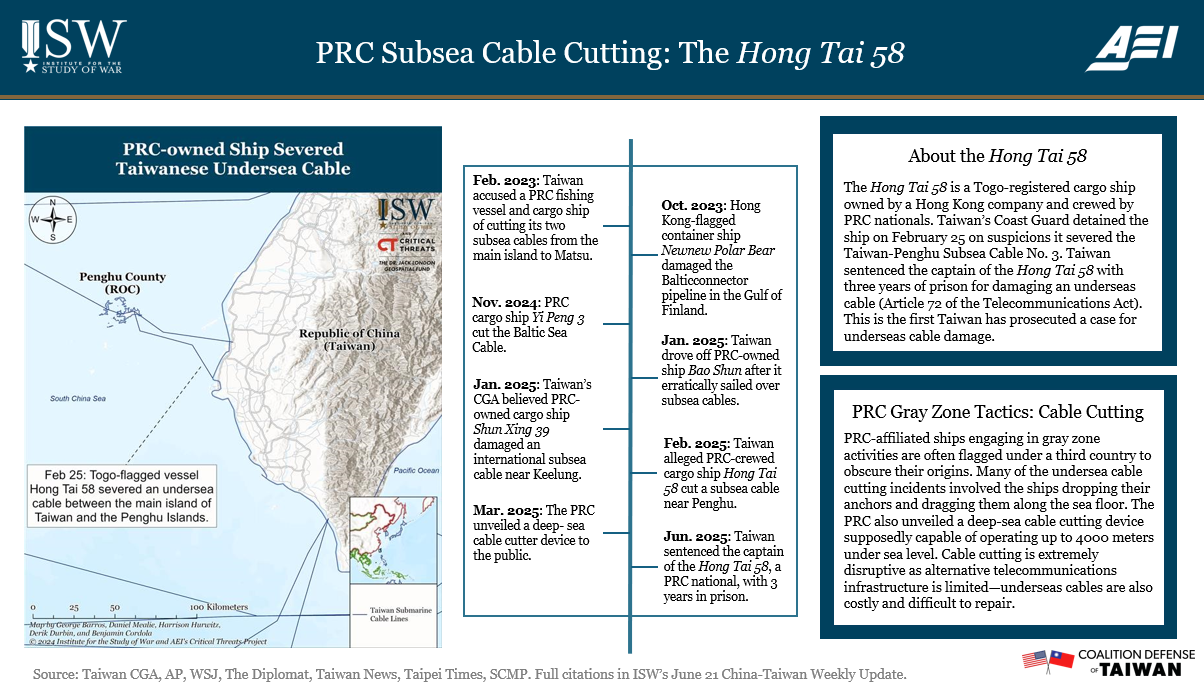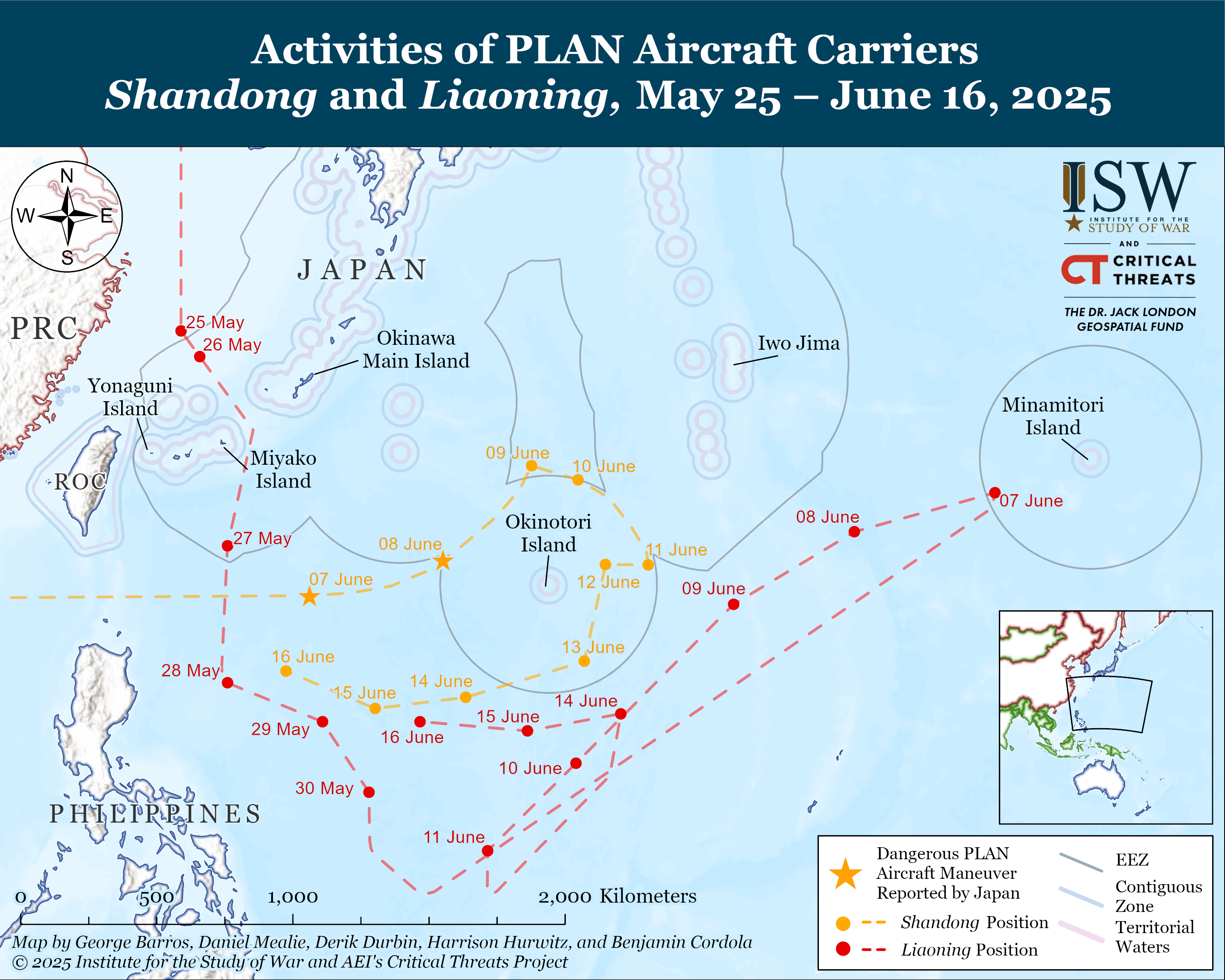Authors: Matthew Sperzel, Daniel Shats, Alison O’Neil, Karina Wugang, and Kiley Pittman of the Institute for the Study of War;
Alexis Turek, Alex Chou, and Luke Jacobus of the American Enterprise Institute
Editors: Dan Blumenthal and Nicholas Carl of the American Enterprise Institute
Data Cutoff: June 18, 2025
The China–Taiwan Weekly Update is a joint product from the Institute for the Study of War and the American Enterprise Institute. The update supports the ISW–AEI Coalition Defense of Taiwan project, which assesses Chinese campaigns against Taiwan, examines alternative strategies for the United States and its allies to deter the Chinese Communist Party’s (CCP) aggression, and—if necessary—defeat the People’s Liberation Army (PLA). The update focuses on the Chinese Communist Party’s paths to controlling Taiwan and cross–Taiwan Strait developments.
Toplines:
The People’s Republic of China (PRC) condemned Israeli strikes on Iran and has publicly advocated for de-escalation in order to protect its interests. PRC support for Iran remains primarily economic, aligning with broader PRC efforts to cast itself as a mediator. Chinese Communist Party (CCP) General Secretary Xi Jinping said that the PRC is “worried” about the “sudden escalation of tensions” in the Middle East and urged for a solution other than military conflict.[1] PRC Foreign Affairs Minister Wang Yi called Iranian Foreign Affairs Minister Abbas Araghchi and said that the PRC is committed to dialogue to prevent escalation.[2] PRC Ministry of Foreign Affairs (MFA) spokesperson Guo Jiakun said that the PRC is in communication with Israel, Iran, and other parties to promote de-escalation.[3] PRC embassies in Iran and Israel have likewise advised PRC citizens to leave.[4]
Elements of PRC messaging have used the situation to criticize US policy and advance PRC narratives. The Global Times—a PRC semi-authoritative state outlet–published a piece saying that “the United States hardly plays a constructive role in alleviating regional conflicts, but it excels at destructive actions.”[5] The same editorial called on the United States to assume responsibility due to its “special influence” over Israel.[6] Such rhetoric aims to distance the PRC from events in the Middle East while shifting blame onto the United States and Israel. These statements align with past PRC rhetoric supporting Iran’s nuclear talks with the United States and opposing sanctions.[7] The MFA similarly called on June 18 on “the country with special influence on Israel,” without directly naming the United States, to de-escalate the conflict.[8]
Other PRC statements have used the conflict to advance narratives on PRC weaponry. Former Global Times editor Hu Xijin wrote that “If Iran had several dozen J-10s, plus a Hongqi series missile air defense system, and with Pakistan’s level of air defense, it would probably not be as easily struck by Israel like this” in a since-deleted post.[9] Hu’s statement echoes PRC narratives following Pakistan’s use of the PRC-supplied J-10 fighter jet during its May 2025 conflict with India.[10] PRC media propagated narratives highlighting the role of the PRC-made jets, including by implying the role they might play in a Taiwan contingency.[11]
Energy security is one of the PRC’s most salient priorities in Iran—Iranian oil accounted for nearly 14 percent of the PRC’s total oil imports in 2024.[12] The PRC has a strong interest in preventing volatility in oil prices, which could result from damage to Iran’s oil facilities or Iran’s intentional closure of the Strait of Hormuz.
The PRC’s interests in preserving stability in Iran could spur more active efforts to de-escalate the conflict. The PRC likely perceives risk that the United States will pursue regime change in Iran alongside Israel, which would deprive the PRC of a key economic and diplomatic partner in the region. PRC arguments against US hegemony are rooted in the view that the United States foments instability and regime change to achieve its national interests, a threat that resonates with the domestic security-obsessed CCP.[13] PRC state media has featured commentary on the crisis that frames the United States as an agitator and warns of instability in pursuing regime change.[14] The PRC is likely scrutinizing Israel’s targeting of domestic control nodes through decapitation strikes and attacks on Iranian state media to glean operational lessons. A deterioration in Iran’s regime security and disruption to global oil markets could spur the PRC to increase its diplomatic efforts to tone down the conflict.
The PRC announced zero-percent tariffs on all African nations except Eswatini, which officially recognizes Taiwan as a country, at the Forum on China-Africa Cooperation (FOCAC) in Changsha. The PRC directly juxtaposed this policy with US tariffs to portray itself as a champion of multilateralism and global economic cooperation. PRC Foreign Affairs Minister Wang Yi co-chaired the forum and met with 11 high-level African officials.[15] The PRC announced on June 11, through a letter from CCP General Secretary Xi Jinping that the country will expand the zero-tariff policy introduced in FOCAC 2024 from 33 least-developed African countries to all 53 African countries that the PRC diplomatically engages.[16] The tariff exemption applies to all goods. Eswatini, formerly known as Swaziland, is the only African country exempted from this policy. It is also the only African country that still maintains diplomatic relations with Taiwan.[17] The PRC has been the African continent’s largest trading partner for the last 15 years, and it imports many raw materials and natural resources critical to PRC industries.[18] Africa-PRC trade substantially increased following the 2024 tariff exemption policies, and trade relations are only expected to deepen with the 2025 policy expansion.[19]
The PRC is actively advancing anti-American sentiment by portraying itself as a generous trade partner in contrast to recent US trade policy. PRC state media Xinhua published the Changsha Declaration, which includes the 10 consensuses made at FOCAC.[20] The declaration includes standard rhetoric on PRC-Africa cooperation and praise for the PRC’s willingness to support multilateralism and international trade, but more notably, the declaration also directly points out the United States’ protectionist policies. The third consensus urged “all countries, especially the United States, to return to the right track of resolving trade differences through consultations in an equal, respectful and mutually beneficial manner.”[21] The PRC is taking any opportunity to juxtapose its trade policies against those of the Donald Trump administration and portray itself as a responsible and globally minded partner. Foreign Affairs Minister Wang Yi presented five proposals for PRC-Africa cooperation during FOCAC that further highlighted this narrative.[22]
Key Takeaways
- PRC: The PRC condemned Israeli strikes on Iran and urged for de-escalation. The PRC’s interest in preserving Iranian regime stability could spur it to take more active efforts in mediating a resolution to the conflict.
- PRC: The PRC announced zero-percent tariffs on all African nations except Eswatini. This decision serves the dual purpose of furthering its economic interests in Africa and punishing states that choose to diplomatically recognize Taiwan.
Cross-Strait Relations
Taiwan
All but two recall petitions for Democratic Progressive Party (DPP) legislators have failed. Taiwan’s mass recall movement has overwhelmingly favored the DPP over the opposition Kuomintang (KMT), increasing the likelihood that the balance of power within the Legislative Yuan (LY) will shift in favor of the DPP. A total of thirteen recall petitions targeting DPP legislators have failed to gather enough signatures to meet the second-stage threshold by their deadline. Two recall petitions have deadlines in late June and are still collecting second-stage signatures.[23] No petitions against DPP legislators have yet cleared the second stage threshold needed to trigger a recall election, while petitions against 31 KMT legislators have passed the second stage and been submitted to the Central Election Commission (CEC) for validation.
CEC head Lee Chin-yung stated on June 12 that the recall votes will be held between July 10 and August 19.[24] The KMT-led opposition currently holds a majority within the LY. The DPP needs to recall at least six KMT legislators and replace them with DPP candidates to gain an LY majority. A DPP-controlled LY would likely undo major government budget cuts targeting key government bodies, approve supplemental budgets, and restore functionality to the Constitutional Court after months of paralysis.
KMT officials have been charged with recall petition forgery multiple times since the beginning of this mass recall wave. The KMT’s inability to amass public support for DPP legislative recalls suggests that KMT support may be lessening among the general public. The Taipei District Prosecutors’ Office charged five KMT Taipei branch officials with forging over 90 percent of the signatures for two DPP legislators, Wu Pei-yu and Rosalia Wu Szu-yao.[25] Polling results from June 16 indicate that the majority of Taiwanese people oppose the mass legislative recall.[26] These results suggest that while pro-DPP grassroots movements have more support than their pro-KMT counterparts, the majority of Taiwanese people oppose the precedent of removing all opposition leaders from the LY.

Taiwan sentenced a PRC national to three years in prison for damaging subsea telecommunication cables. This is the first time Taiwan has prosecuted an undersea cable sabotage case. Taiwan received reports from its largest telecommunications provider, Chunghwa Telecom, that the Taiwan-Penghu Subsea Cable No.3 was completely severed on February 25.[27] The disconnection occurred 14.7 kilometers off the southwest coast of Taiwan’s main island within internal waters.[28] Taiwan’s Coast Guard Administration (CGA) detained the Togo-flagged cargo ship Hong Tai 58 and detained its eight crew members, who were all PRC nationals.[29] The ship acted suspiciously prior to the incident, including, but not limited to, having multiple names, turning on and off AIS data, and sailing around the Taiwan Strait with only one cargo record in the past year.[30] Prosecutors announced in April 2025 charges against the captain of the ship. The other seven crew members were released and sent back to the PRC.[31] Tainan District Court sentenced the captain under Article 72 of the telecommunications law for damaging undersea cables.[32] This is the first time Taiwan has charged and sentenced any individual for damaging undersea cables.
The PRC has been implicated in sabotaging submarine cables numerous times in the past. Physical sabotage is an element of PRC aggression against Taiwan. PRC-owned boats are often flagged under a third country to obscure their origins, as was the case with all three PRC-owned ships accused of undersea cable sabotage around Taiwan in 2025: Bao Shun, Shun Xing 39, and the Hong Tai 58 (see graphic timeline for details). The PRC is pursuing malign activities targeting Taiwan’s telecommunications infrastructure to disrupt, deny, and degrade the efficiency of communication and the flow of information. Undersea cable sabotage is also very costly to repair—Chunghwa Telecom spent 17 million New Taiwan dollars (576,564 US dollars) to repair the Taiwan-Penghu Subsea Cable No.3.[33]

The Taiwanese government criticized former Taiwanese President Ma Ying-jeou’s participation in the PRC-hosted Straits Forum as support for PRC propaganda efforts. The Straits Forum is an annual provincial-level forum that focuses on fostering connections between Taiwan and the nearby PRC province of Fujian. Ma attended the event on June 15, where he met with high-ranking CCP officials and called for greater cross-strait cooperation. The PRC’s presentation of Ma as the foremost representative of Taiwan at the forum demonstrates its efforts to position Taiwanese figures who are outspokenly pro-integration as key players in cross-strait relations.
Taiwan’s Mainland Affairs Council (MAC) called the Straits Forum on June 11 a platform for United Front work and accused Ma of knowingly cooperating with the CCP’s political manipulation.[35] Ma doled out praise for the PRC throughout his trip, including commending Xi Jinping’s poverty alleviation campaign, which is a staple achievement of Xi’s tenure that the CCP touts to support public legitimacy.[36]
Ma leads regular trips to the PRC, usually under his organization, the Ma Ying-jeou Foundation, which conducts cross-strait youth exchanges. This is the first Straits Forum that Ma has attended; however, whereas incumbent KMT leaders were the principal guests at past forums.[37] KMT leaders did not attend the forum this year, possibly due to concerns that public sensitivities over KMT-CCP engagement could negatively impact the party’s standing amid mass legislative recall campaigns.[38]
PRC encouragement of Ma’s participation in cross-strait affairs likely aims to bolster his influence within the KMT and exploit his organization’s access to Taiwanese youth, which the PRC has identified as a primary target of United Front work. The United Front is a whole-of-government and society effort to advance CCP ideology and interests by co-opting non-government segments of “Chinese” society. United Front activities against Taiwan aim to inculcate in the Taiwanese public CCP notions that the PRC is the only legitimate government of China and that Taiwan is a part of that China.
China
The PRC added 100 nuclear warheads in the last year, making its nuclear arsenal the fastest growing in the world. Stockholm International Peace Research Institute (SIPRI) released its yearly tracker of global nuclear arsenals on June 16 and estimated that the PRC’s nuclear arsenal has reached 600 warheads, with 24 deployed and 576 stored.[39] SIPRI reported that “Depending on how it decides to structure its forces, China could potentially have at least as many ICBMs as either Russia or the USA by the turn of the decade.”[40] The country in possession of the most warheads is Russia, with a total inventory of 5,459 in 2025.[41]
SIPRI’s findings align with estimates made by the Federation of American Scientists (FAS), which reported in March 2025 that the PRC possesses approximately 600 warheads and is rapidly expanding its arsenal (up from a previous 500 in 2024).[42] FAS estimated that most of these warheads are in storage and that the PRC is not a nuclear “peer” of the United States in terms of its capabilities spanning the nuclear triad.[43]
The PRC first tested a nuclear weapon in 1964 and has since maintained a policy of no first use.[44] The PRC has rapidly expanded its arsenal under Xi Jinping, however, including by reorganizing its Second Artillery Corps into the PLA Rocket Force in 2015. The PRC fears “nuclear blackmail” by the United States and may consider its nuclear arsenal a deterrent against US intervention in a Taiwan contingency.[45]
Northeast Asia
Japan
People’s Liberation Army Navy (PLAN) J-15 fighter jets launched from the aircraft carrier Shandong conducted dangerous maneuvers near a Japan Maritime Self Defense Force P-3C patrol aircraft. Japanese Defense Minister Gen Nakatani stated that the Japanese aircraft were monitoring the Shandong carrier strike group as it operated near Japan’s Okinotori Island.[46] Nakatani condemned the J-15s’ dangerous maneuvers that could trigger accidental collisions. Following the incident, the Japanese Ministry of Defense (MOD) detected approximately 230 flight operations from CNS Shandong from June 9 to 16.[47] MOD also reported approximately 290 flight operations from CNS Liaoning, which was also operating in the Pacific, between June 8 and 16.
PRC MFA spokesperson Lin Jian claimed that the PLAN aircraft’s activities complied with international laws and customs.[48] Lin further shifted the blame by attributing the root cause of dangerous maneuvers to Japan’s surveillance of the PRC’s “normal military activities.” The PLA has a record of conducting dangerous maneuvers in the sea and air, however.[49] The US Department of Defense reported in 2023 that there had been “an increase in unsafe and unprofessional intercepts of US and allied forces lawfully operating in international zones throughout the Indo-Pacific region” by PLA vessels and aircraft.[50]
North Korea

Satellite imagery and reports indicate that North Korea is continuing to build and modernize its military capabilities. Worker’s Party of Korea General Secretary Kim Jong Un visited the Huichon Ryonha CNC machine production plant, which produces components for advanced munitions, last month. Satellite imagery shows that around the time of Kim’s visit, the plant began construction of the largest single production hall in North Korea.[51] Kim also oversaw the launch of North Korea’s second Choe Hyon-class destroyer on June 12. The ship capsized during its first attempted launch in late May. NK News analyst Colin Zwirko noted the similarities between the Russian Pantsir-ME and a system used on the first Choe-Hyon class destroyer, suggesting that Russian components or systems may also be used for the second destroyer.[52] Kim made a speech at the second, successful launch, accusing the United States of “provocative intentions,” criticizing “constant” US naval deployments to the region, and announcing that North Korea would be continuing its naval buildup and deploying two destroyers per year, beginning in 2026, in response.[53] North Korean state media showed Kim inspecting a factory producing precision guided multiple launch rocket system (MLRS) shells on June 13. North Korea exports these shells to Russia for use in the Ukraine war.[54] The factory complex underwent significant expansion and reconstruction, which appears to have been completed around January 2024.[55] North Korean state media published images of Kim appearing in person at both factories and at the launch ceremony, and his daughter, Kim Ju Ae, accompanied him to the MLRS shell factory and the launch.[56]
The International Atomic Energy Agency reported that North Korea is also building a suspected new uranium enrichment plant at Yongbyon, which already hosts several such facilities supporting the country’s nuclear weapons program.[57] North Korea has continued high levels of production of highly enriched uranium since Kim Jong Un announced his policy of “exponentially boosting the production of nuclear weapons” to resist the United States and its allies in a “new Cold War” in 2023, with the Supreme People’s Assembly formally adding the policy to North Korea’s constitution.[58]
Kim’s personal appearances at the military manufacturing facilities and the destroyer launch, as well as the inclusion of his daughter, likely indicate the high degree of importance Kim places on these expansions of North Korea’s military capabilities and arms production capacity. Kim also likely seeks to project an image of North Korean military strength after massive casualties among North Korean troops participating in Russia’s invasion of Ukraine and the failed launch of its second Choe Hyon-class destroyer in May.[59]
North Korean diplomats rejected a letter from US President Donald Trump seeking to reopen communication with Kim Jong Un.[60] This likely reflects North Korea’s enhanced military capabilities and relationship with the United States’ adversaries. Trump has repeatedly referenced his relationship and past meetings with Kim since his inauguration and publicly stated that he intends to reopen talks with Kim.[61] The United States issued a policy restricting the entry of foreign nationals from 19 countries, not including North Korea, which came into effect in June. North Korean state media published a commentary criticizing the restrictions, calling the US “the most hostile country” to North Korea, and stating that North Korea’s exclusion from the list may be a “carrot” offered by the Trump administration to resume dialogue.[62] The North Korean response indicated that such a resumption was unlikely in the near future. North Korea provided no reason for the letter’s rejection. North Korea’s increased confidence in its military strength, bolstered by ongoing nuclear weapons production, military modernization efforts, and expanding drone, naval, and other military capabilities, may have led Kim to view dialogue with the US as currently unnecessary to ensure his regime’s security. North Korea’s relationship with Russia also likely plays a role. North Korea and Russia have increased trade, military, and technological links over recent years, and increased Russian hostility toward the US over its support of Ukraine may incentivize Kim to rebuff US attempts at outreach.
South Korea
South Korean President Lee Jae-myung continues to pursue a balancing strategy, seeking to reduce tensions with North Korea and maintain strong relations with the United States and Japan. Lee directed officials to draft punitive measures on June 14 following a report that a civic group attempted to send anti-North Korean leaflets and balloons into border areas.[63] Lee affirmed his commitment to reducing tensions on June 15, decrying activists for “jeopardizing the safety of border area residents.” Lee announced on June 11 that South Korea would halt anti-North Korean loudspeaker broadcasts along the border.[64] South Korea’s Joint Chiefs of Staff announced that North Korea acted in kind the following day.[65] North Korea’s actions indicate that they may be willing to ratchet down coercive operations in accordance with South Korean behavior. It is, however, unlikely that Pyongyang will drastically change its policies, given continued investment in its military and nuclear development.
The United States, South Korea, and Japan conducted combined aerial exercises on June 18, the same day as South Korea’s first live-fire artillery exercises along the inter-Korean border since Lee entered office. The South Korean Air Force stated that these drills would enhance trilateral security cooperation amid growing threats from North Korea’s nuclear program. The artillery drills mark an expansion of South Korean military activity along the border, following the June 2024 suspension of the 2018 inter-Korean Comprehensive Military Agreement (CMA). The CMA prohibited such exercises in border areas. Lee promised to reinstate the CMA upon taking office, though no steps have been taken to do so. South Korean military exercises are likely intended to further cooperation with allies and partners and ensure that Lee’s desire to reduce tensions with North Korea is not viewed as an indication of destabilizing defense policy shifts that would threaten the interests of Japan or the United States. South Korean military exercises are likely intended to send a message to North Korea as well, signaling to Pyongyang that South Korea will continue to defend itself despite the ratcheting down of some of its operations directed at North Korea.
Southeast Asia
Philippines
The Philippines is continuing to shift its military focus toward external defense in the South China Sea by preparing to deploy an army unit to support existing naval and coast guard forces on occupied islands. Philippine Army Chief Lieutenant General Roy Galido said on June 10 that the Philippines will “soon” deploy an army contingent to support law enforcement units on occupied islands in the South China Sea, currently assigned to nine features in the Spratly Island group. An army contingent deployment would allow the Philippines to carry out exercises further into the West Philippine Sea.[66] The deployment of the army contingent to the Spratly Island group aligns with the Comprehensive Archipelagic Defense Concept (CADC), a policy growing in importance under the Marcos administration. The CADC has not been cited as the reason for the development of the strategy, however.
The Philippines’ focus on external defense in the South China Sea is a response to continued PRC encroachment. Philippine Navy spokesman Rear Admiral Roy Vincent Trinidad said that the PRC deploys naval assets to respond to the Philippines’ joint exercises with its allies to justify the PRC’s “continued illegal presence in [the Philippines] maritime zones.”[67] The PLA held joint sea and air patrols on the South China Sea on June 14 after Galido announced the upcoming deployment of the Philippine army contingent to the Spratly Island group.[68] PLA Southern Theater Command spokesperson Tian Junli said that the Philippines has “courted” countries outside the region to organize “joint patrols” and “raised security risks” in the South China Sea.[69] Tian’s statement is likely a veiled reference to recent US-Philippine joint exercises in the region. The United States and the Philippines conducted the 2025 Balikatan exercise from April 22 to May 8, which included the first uses of the Navy-Marine Expeditionary Ship Interdiction System (NMESIS) and the Marine Air Defense Integrated System (MADIS).[70] The Kamandag 9 exercises took place from May 26 to June 6.[71] The PRC has expressed concerns about the deployment of US missile systems to the Philippines as joint exercises between the United States and the Philippines increase. The Philippines’ plans to purchase “Typhoon land-based medium-range missile system or similar platforms” and the Philippine Navy’s announcement that the NMESIS will remain in the Philippines “for training purposes” will increase the Philippines’ defense capacity but likely exacerbate the PRC’s concerns.[72]

[1] https://www.globaltimes dot cn/page/202506/1336357.shtml; https://www.globaltimes dot cn/page/202506/1336356.shtml
[2] https://www.globaltimes dot cn/page/202506/1336131.shtml
[3] https://www.globaltimes dot cn/page/202506/1336345.shtml
[4] https://www.msn.com/en-gb/news/world/china-evacuates-citizens-from-iran-and-israel-urges-ceasefire/ar-AA1GSlp4?ocid=BingNewsSerp
[5] https://www.globaltimes dot cn/page/202506/1336302.shtml
[6] https://www.globaltimes dot cn/page/202506/1336302.shtml
[7] https://www.reuters.com/world/china-backs-irans-nuclear-talks-with-us-opposes-illegal-sanctions-2025-04-23/
[8] https://www.fmprc.gov dot cn/eng/xw/fyrbt/lxjzh/202506/t20250618_11652681.html
[9] https://www.newsweek.com/china-state-media-israel-iran-airstrikes-defenses-arms-sales-2086463
[10] https://www.newsweek.com/india-pakistan-war-china-fighter-jets-missile-defenses-2070168
[11] https://understandingwar.org/backgrounder/china-taiwan-weekly-update-may-23-2025
[12] https://data.stats dot gov.cn/easyquery.htm?cn=C01&zb=A0707&sj=2024
[13] http://paper.people dot com.cn/rmlt/html/2023-05/15/content_25999958.htm
[14] https://content-static.cctvnews.cctv dot com/snow-book/index.html?item_id=5487615705565516353&toc_style_id=feeds_default&share_to=copy_url&track_id=7af3afed-325b-4046-9611-1e93970bc372
[15] https://www.mfa dot gov.cn/web/wjdt_674879/gjldrhd_674881/202506/t20250612_11647115.shtml
[16] https://www.scmp dot com/news/china/diplomacy/article/3314143/china-remove-tariffs-nearly-all-goods-africa-both-criticise-us-trade-moves
[17] https://www.internationalaffairs.org.au/australianoutlook/taiwans-diplomatic-setback-how-much-longer-will-eswatini-maintain-diplomatic-ties-with-taiwan/
[18] https://www.bbc.com/news/articles/czdy6qdln4jo
[19] https://www.scmp dot com/news/china/diplomacy/article/3259601/china-africa-trade-gets-boost-critical-minerals-needed-ev-battery-production#:~:text=It%20is%20a%20trade%20surplus,largely%20exports%20finished%20industrial%20products.
[20] http://www.news dot cn/world/20250611/e3c64717dc074f3281a9e4604441abbf/c.html
[21] http://www.newsc dot n/world/20250611/e3c64717dc074f3281a9e4604441abbf/c.html
[22] https://www.mfa.gov dot cn/web/wjdt_674879/gjldrhd_674881/202506/t20250611_11645656.shtml
http://www.news dot cn/world/20250611/4e860789d56f4058b4a2062d4941a158/c.html
[23] https://www.rti.org dot tw/news/view/id/2253332
[24] https://focustaiwan dot tw/politics/202506120009
[25] https://www.taiwannews.com dot tw/news/6135452
[26] https://www.taiwannews.com dot tw/news/6135242
[27] https://moda dot gov.tw/en/press/press-releases/15362
[28] https://moda dot gov.tw/en/press/press-releases/15362
[29] https://www.bbc.com/news/articles/cwy3zy9jvd4o
[30] https://www.taipeitimes dot com/News/front/archives/2025/03/02/2003832732
https://www.bbc.com/news/articles/cwy3zy9jvd4o
[31] https://www.cnn.com/2025/04/11/world/taiwan-chinese-ship-charges-deep-sea-cables-intl-hnk
[32] https://focustaiwan dot tw/society/202506120025
https://www.ocac dot gov.tw/OCAC_OLD/Pages/Detail.aspx?nodeid=329&pid=74444422
[33] https://www.reuters.com/business/media-telecom/taiwan-jails-chinese-ship-captain-damaging-undersea-cables-2025-06-12/
[34] Map: https://www.cga dot gov.tw/GipOpen/wSite/ct?xItem=164475&ctNode=650&mp=999
Matsu incident: https://apnews.com/article/matsu-taiwan-internet-cables-cut-china-65f10f5f73a346fa788436366d7a7c70
Newnew Polar Bear incident: https://apnews.com/article/finland-estonia-china-vessel-baltic-sea-gas-pipeline-39334c9c565753c7e189c6efc302e43e
Yi Peng 3: https://thediplomat.com/2025/01/another-severed-submarine-cable-raises-alarm-in-taiwan/
Bao Shun: https://www.taiwannews dot com.tw/news/6007959
Hong Tai 58: https://www.cga dot gov.tw/GipOpen/wSite/ct?xItem=164475&ctNode=650&mp=999
Shun Xing 39: https://www.taipeitimes dot com/News/taiwan/archives/2025/01/05/2003829674
Deep seas cable cutter: https://www.scmp dot com/news/china/science/article/3303246/china-unveils-powerful-deep-sea-cable-cutter-could-reset-world-order
[35] https://www.mac dot gov.tw/News_Content.aspx?n=05B73310C5C3A632&sms=1A40B00E4C745211&s=4EF3EA1B7CEF990C
[36] https://udn dot com/news/story/7331/8818461
[37] http://www.gwytb dot gov.cn/m/headline/202406/t20240615_12628069.htm
www.taiwan.cn/hxlt/16j_66819/yw/202506/t20250616_12706707.htm
[38] https://www.taipeitimes dot com/News/taiwan/archives/2025/06/12/2003838483
[39] https://www.sipri.org/media/press-release/2025/nuclear-risks-grow-new-arms-race-looms-new-sipri-yearbook-out-now
[40] https://www.sipri.org/media/press-release/2025/nuclear-risks-grow-new-arms-race-looms-new-sipri-yearbook-out-now
[41] https://www.sipri.org/media/press-release/2025/nuclear-risks-grow-new-arms-race-looms-new-sipri-yearbook-out-now
[42] https://fas.org/publication/nuclear-notebook-china-2025/; https://thebulletin.org/premium/2024-01/chinese-nuclear-weapons-2024/
[43] https://fas.org/publication/nuclear-notebook-china-2025/
[44] https://www.mfa.gov dot cn/web/wjb_673085/zzjg_673183/jks_674633/fywj_674643/202407/t20240722_11457979.shtml
[45] https://understandingwar.org/backgrounder/china-taiwan-weekly-update-february-8-2024; https://www.nytimes.com/2024/02/04/world/asia/china-nuclear-missiles.html
[46] https://www.mod.go dot jp/j/press/kisha/2025/0613a.html ; https://www.mod.go dot jp/js/pdf/2025/p20250609_02.pdf
[47] https://www.mod.go dot jp/js/pdf/2025/p20250617_01.pdf
[48] mfa.gov dot cn/web/wjdt_674879/fyrbt_674889/202506/t20250612_11647042.shtml
[49] https://www.cbsnews.com/news/chinese-warship-u-s-missile-destroyer-taiwan-strait-close-call-uss-chung-hoon/ ; https://apnews.com/article/china-fighter-jet-intercept-7e8d4f24bfcb445297eff68e20f1429d ; https://www.defence.gov dot au/news-events/releases/2024-05-06/statement-unsafe-unprofessional-interaction-pla-air-force ; https://thedefensepost.com/2025/02/18/philippines-china-helicopter-maneuvers/
[50] https://www.defense.gov/News/News-Stories/Article/Article/3421766/defense-leaders-see-increase-in-risky-chinese-intercepts/
[51] https://www.nknews.org/pro/north-korea-starts-work-on-what-could-become-countrys-largest-military-factory/
[52] https://www.nknews.org/pro/north-koreas-damaged-warship-begins-repairs-near-port-hosting-russia-arms-trade/
[53] https://www.nknews.org/2025/06/north-korea-launches-warship-at-major-ceremony-weeks-after-disaster-repairs/
[54] https://www.nknews.org/2025/06/kim-jong-un-promotes-rocket-production-at-factory-likely-making-arms-for-russia/?popup=signin&login=recaptcha
[55] https://www.nknews.org/pro/satellite-imagery-shows-kim-jong-uns-east-coast-yacht-missile-test-activities/
[56] https://www.nknews.org/pro/north-korea-starts-work-on-what-could-become-countrys-largest-military-factory/; https://www.nknews.org/2025/06/kim-jong-un-promotes-rocket-production-at-factory-likely-making-arms-for-russia/?popup=signin&login=recaptcha; https://www.nknews.org/2025/06/north-korea-launches-warship-at-major-ceremony-weeks-after-disaster-repairs/
[57] https://nonproliferation.org/suspect-enrichment-facility-in-the-dprk/
[58] https://apnews.com/article/north-korea-kim-cold-war-nuclear-72087705d2276860fbe4edd999930ba8
[59] https://www.scmp dot com/news/asia/east-asia/article/3314586/north-korean-casualties-surpass-6000-ukraine-war-uk-intelligence-says?module=Asia&pgtype=section
[60] https://www.nknews.org/2025/06/north-korea-refusing-to-accept-trump-letter-aimed-at-restarting-dialogue-source/
[61] https://www.nknews.org/2025/01/donald-trump-says-he-will-reach-out-to-north-korean-leader-kim-jong-un-again/; https://www.nknews.org/2025/03/trump-signals-further-willingness-to-resume-talks-with-kim-jong-un/
[62] https://www.newsweek.com/north-korea-responds-us-entry-ban-trump-policy-2083749
[63] https://www.koreatimes.co dot kr/foreignaffairs/northkorea/20250616/seoul-moves-away-from-confrontation-with-pyongyang
[64] https://www.nknews dot org/2025/06/seoul-says-it-halted-loudspeaker-broadcasts-into-north-korea-to-restore-trust/
[65] https://www.chosun dot com/english/north-korea-en/2025/06/12/YQLRNEBYYRAIRFOLM6WSBO24XY/
[66] https://www.scmp dot com/week-asia/politics/article/3314379/philippine-army-unit-be-deployed-soon-south-china-sea-islands?module=perpetual_scroll_0&pgtype=article
[67] https://www.pna dot gov.ph/articles/1252388
[68] https://www.reuters.com/world/china/chinas-military-conducts-patrols-south-china-sea-warns-philippines-2025-06-15/
[69] https://www.reuters.com/world/china/chinas-military-conducts-patrols-south-china-sea-warns-philippines-2025-06-15/
[70] https://www.pacom.mil/Media/NEWS/News-Article-View/Article/4182126/3d-mlr-concludes-balikatan-25-prepares-for-kamandag-9/#:~:text=Now%20that%20Exercise%20Balikatan%2025,with%20Allies%20and%20partner%20nations
[71] https://www.pacom.mil/Media/NEWS/News-Article-View/Article/4182126/3d-mlr-concludes-balikatan-25-prepares-for-kamandag-9/#:~:text=Now%20that%20Exercise%20Balikatan%2025,with%20Allies%20and%20partner%20nations
[72] http://www.news dot cn/milpro/20250613/af7ab93500ff41a584d049930785c9aa/c.html







